#Reykjanes peninsula
Text


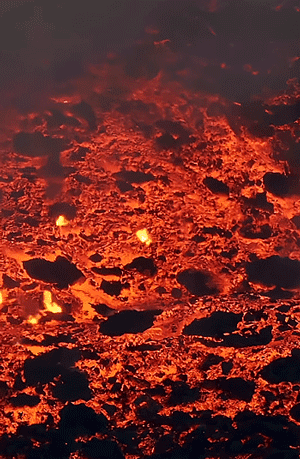

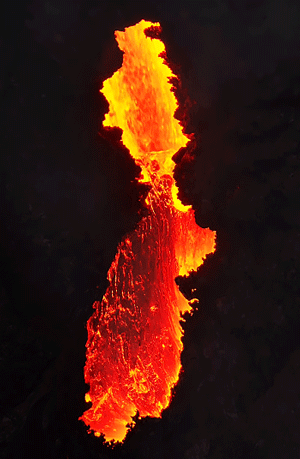

Lava Rivers & Streams l jvn.photo l Iceland
#volcano#iceland#volcanoes#earth#volcanic eruption#lava#magma#volcanic ash#planets#fagradalsfjall#Litli Hrútur#reykjanes peninsula#nature
2K notes
·
View notes
Photo

Headed home for the Holidays, Extreme Offroad Iceland (@offroad_iceland)
491 notes
·
View notes
Text

Lava Fountain
Fagradalsfjall Volcano eruption on the Reykjanes Peninsula, Iceland
Photographer: Ridhima Singh
The International Photo Awards 2022
#ridhima singh#photographer#lava fountain#eruption#fagradalsfjall volcano#volcanic eruption#reykjanes peninsula#iceland#nature#landscape#the international photo awards
120 notes
·
View notes
Text

Eldfjallaströnd, Reykjanesskagi, Ísland, 2023.
110 notes
·
View notes
Text
Crater Collapses in Iceland's New Volcano Spewing Rivers of Lava
Iceland's newest volcano, located in the Reykjanes peninsula, began erupting in early July, 2023. Now it's throwing "spatter bombs'" of molten lava.
In Iceland, the world's newest "baby" volcano is throwing a temper tantrum: It's overflowing and spewing "spatter bombs," or blobs of molten lava, into the surrounding crater.
The volcano formed on July 10, when an underground eruption opened a 1.7-mile-long (2.7 kilometers) fissure in the ground of Iceland's Reykjanes peninsula, southwest of the capital, Reykjavík. Leading up to this event, the region experienced a "seismic swarm," during which more than 7,000 earthquakes shook the area starting on July 4, according to a statement from the Icelandic Met Office. Lava trickled from the fracture in the ground, and seismic activity decreased for about a week after the eruption.
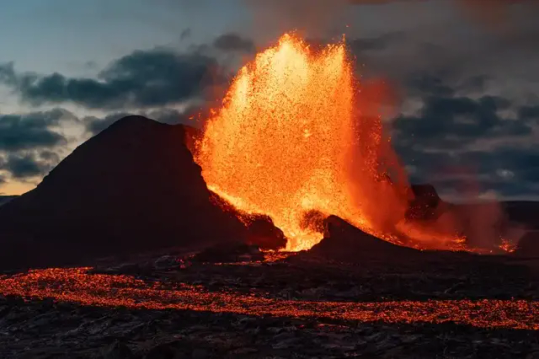
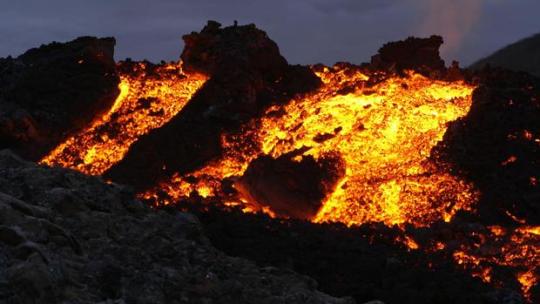
On July 18, however, "there was a major shift in the vent activity overnight," according to a post on the Facebook page of Rannsóknarstofa í eldfjallafræði og náttúruvá (the Laboratory of Volcanology and Natural Hazards), a research group from the University of Iceland. At around 11:30 p.m. local time, "the crater filled up to the brim with lava and the fountaining began to throw spatter bombs well beyond the crater rims." Roughly three hours later, a small opening formed, allowing lava to spill over the crater, the post added. By early morning, a section of the crater's rim had collapsed, releasing a river of lava to the north and west. The lava pouring from this crater is roughly 2,192 degrees Fahrenheit (1,200 degrees Celsius), the scientists said.
"The crater became unstable and collapsed," Ingibjörg Jónsdóttir, an associate professor of geography at the University of Iceland and member of the lab, told Live Science in an email. "It had built up quite fast and it was filling up with lava on the inside, causing pressure to the walls. Not unusual as such but spectacular and of concern since there were people quite close by not long before it happened (in a closed area though)."
On the opposite side of the volcano, lava flowing south stalled and eventually crusted over, the post said. The area around the eruption site is uninhabited, and the eruption does not currently post a risk to infrastructure, according to the Icelandic Met Office. Firefighters in Grindavík, a nearby Icelandic town, have already contained the potential spread of fire from July 18's lava spill, and they no longer believe it is a threat, according to the Icelandic National Broadcasting Service.
Scientists will continue to monitor the volcano's behavior because future lava flows could ignite wildfires and reduce air quality in the region, according to the statement. Watch a livestream of the volcano on the Icelandic National Broadcasting Service's website here.
By Kiley Price.

#Crater Collapses in Iceland's New Volcano Spewing Rivers of Lava#reykjanes peninsula#volcano#baby volcano#eruption#erupting#lava#molten lava#nature#nature video
100 notes
·
View notes
Text
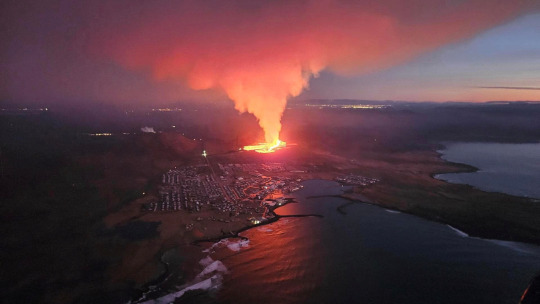
Iceland Civil Protection - A volcano spews lava and smoke as it erupts in Reykjanes Peninsula, Iceland, January 14, 2024
12 notes
·
View notes
Photo
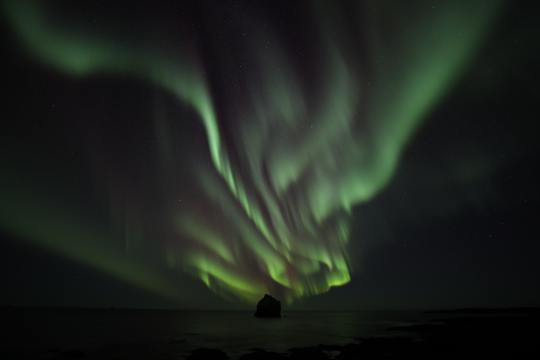

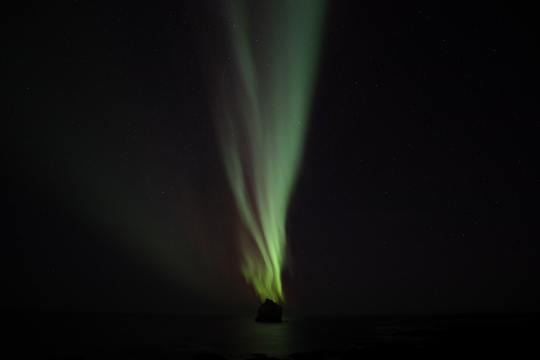
“ The northern lights “ // Toby Elliott
98 notes
·
View notes
Text
heavy machinery, that was being used to make protective walls, being saved from the lava flow
#they will need to be used when the flow stops again#iceland#eruption#volcano#grindavík#reykjanes peninsula#nature
13 notes
·
View notes
Photo

By Sverrir Thorolfsson
Kleifarvatn, Reykjanes Peninsula, Iceland
#curators on tumblr#iceland#europe#travel#landscape#nature#kleifarvatn#reykjanes peninsula#sverrir thorolfsson
10 notes
·
View notes
Text

Latest eruption at Sundhnúkur on the Reykjanes Peninsula, Iceland. 22.03.2024
Taken during a helicopter flight over the volcanic region - this was and still is the only way to see the eruption as the area is completely closed off to public.
This was a dream come true and a very last minute, and emotional trip. I’m so grateful that I could go 🌋🇮🇸❤️
#Sundhnúkur#reykjanes peninsula#volcano#lava#volcanic crater#lava river#volcanic gas#lava fields#volcanic eruption#Iceland#wanderlust#dream come true#volcanology
1 note
·
View note
Text
BT Travel - Tour Agency in Iceland

Discover Iceland with BT Travel – where luxury meets adventure! Our premier tour agency ensures unparalleled comfort with private transport and passionate driver-guides, crafting personalized journeys tailored to your unique preferences. Experience the magic of the Northern Lights, explore the wonders of the Golden Circle, relax in the Blue Lagoon, and uncover the rugged beauty of the Reykjanes Peninsula. From solo adventurers to romantic getaways or group expeditions, every journey with BT Travel is an unforgettable adventure in the heart of Iceland!
#iceland#northern lights#golden tour#reykjanes peninsula#travel#iceland tour agency#iceland travel company#iceland day tour#reykjavik airport transfer#Northern lights tour#reykjavik aurora borealis tour#Golden circle tour
1 note
·
View note
Text

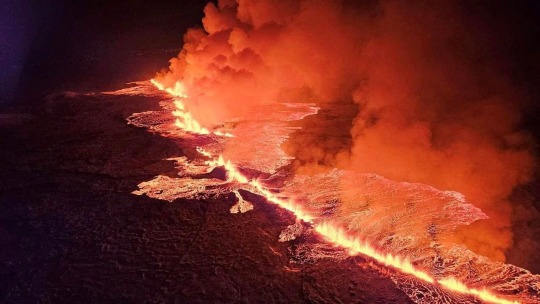


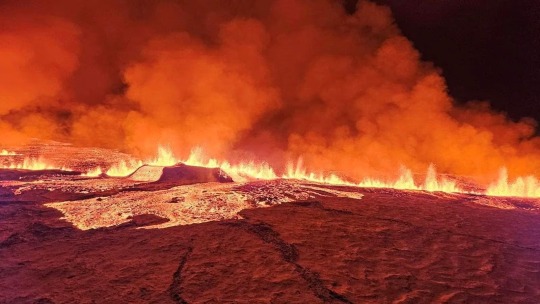
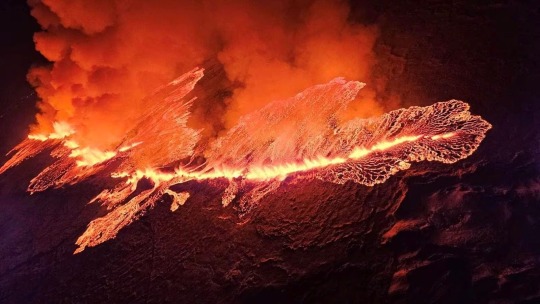
Iceland's erupting volcano from above
l Grindavík l Dec. 18-19 2023 via REUTERS
#volcano#reuters#volcanoes#iceland#reykjanes peninsula#drone footage#volcanic eruption#photography#grindavik#december#2023#reuters pictures
2K notes
·
View notes
Text
NASA Earth Observatory: Another Eruption in Iceland
FromEarthOrbit, #PlanetEarth, #OurHomeInSpace, #TheOverviewEffect
Hot stuff! 🌋
Satellites measured the infrared heat signature of three recent volcanic eruptions in southwestern Iceland. The first two lava flows appear black, while last week’s eruption radiates heat, which appears red/orange in this #Landsat image - #NASAEarthObservatory
#Iceland Volcano#NASA Earth Observatory#SW Iceland#Volcano heat signature#Landsat Image#Reykjanes Peninsula#EarthObservatory.NASA.gov
0 notes
Text

Iceland Volcano Lava Eruption Litli-Hrútur 2023 Reykjanes Peninsula Reykjavik IS Mavic 3 Pro Cine Fine Art Aerial Landscape Photography Iceland!
Elliot McGucken Master Fine Art Nature Photographer
By 45SURF Hero’s Odyssey Mythology Photography
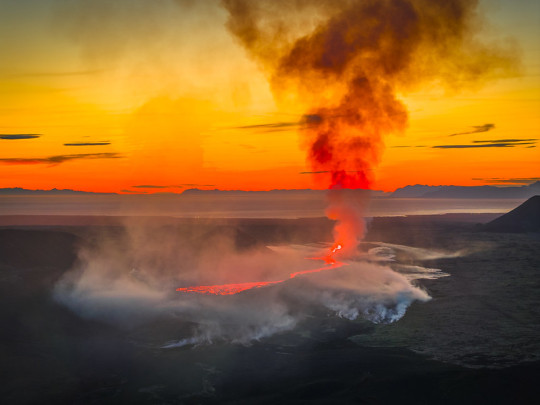
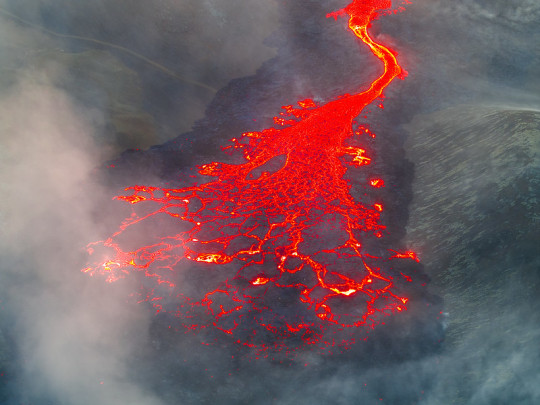
#4surf hero's odyssey mythology photography#elliot mcgucken master fine art nature photographer#photographer#iceland#volcanic eruption#lava#litli hrútur#volcano#reykjanes peninsula#reykjavik#aerial landscape#nature
89 notes
·
View notes
Text


Virkjun og jarðhitalög í hættu vegna eldgossins við Grindavík, 2023.
The upper photo is looking toward the location of the eruptions from about 15 km away but taken 3 months before the lava flows began. The power plant, which stretches over a considerable area, and the geothermal heating system serving SW Iceland are both under severe threat with the main road leading to them already cut by lava flows. The Icelandic government has constructed dikes to divert the lava, but that is uncertain protection.
Having recently read the novel The Fires by Sigríður Hagalín Björnsdóttir (sadly in English, for my command of Icelandic is feeble to say the least) gives me a strong desire to see the volcanic activity currently ongoing on the Reykjanes Peninsula. Wish I could hop on an Iceland Air plane, but that is not going to happen.
7 notes
·
View notes
Text

Local residents watch as lava-fueled smoke colors the night sky orange. This volcanic pyre has already cemented its reputation as one of the most consequential and scientifically beguiling Icelandic eruptions of the last few decades. Photograph By Kristen Elizabet Gunnarsdottir, AFP/Getty Images
Why Iceland's Latest Eruption May Be The Most Dangerous In Recent History
The December 18 explosion is the region’s fourth in three years—and has fired out 10 times more lava per second than any of the past three at their peaks. Here's what happens next.
— By Robin George Andrews | Published December 19, 2023
It was perhaps only a matter of time before Iceland’s Reykjanes Peninsula ran out of luck.
During the night of December 18, the peninsula exploded in a volcanic outburst—its fourth in under three years, and a decidedly dangerous entry in the Nation’s Volcanic Saga.
Just two hours after a swarm of earthquakes warned of the impending eruption, it was firing out 10 times more lava per second than any of the past three at their peaks, all while the fissure itself expanded to an astonishing 2.5 miles in length in a matter of minutes.
After nearly a millennium of dormancy, this southwesterly strip of land entered a new volcanic era in March 2021. The past three eruptions—in 2021, 2022, and earlier this summer—were nothing less than scientific and aesthetic spectacles. The last time there was a period of multiple eruptions on the peninsula was in the early 13th century. That it is undergoing another similar span of lava-oozing eruptions is one reason the world has been watching so closely.
But this fourth eruption has caught the attention of the international media for another three reasons: the ramp up to the main event was unusual compared to the last three; the location, combined with its vigorous opening salvo of molten rock, threatens to destroy a town; and its overall behavior created an uncomfortable amount of uncertainty as to what may happen next.

The evacuated Icelandic town of Grindavik is seen here as smoke billows and lava is thrown into the air from a fissure during a volcanic eruption on the Reykjanes Peninsula on December 19. The eruption began on Monday night following an earthquake swarm. Photograph By Viken Kantarci, AFP/Getty Images
“Just in context of the past three years on the Reykjanes Peninsula, it is pretty mind-blowing,” says Tom Winder, a volcano Seismologist at the University of Iceland.
As of the afternoon of December 19, just a third of the fissure remains volcanically active, and the eruption’s output has greatly diminished. Things could still change for the worse, but hopefully it continues to fizzle.
Regardless, this volcanic pyre has already cemented its reputation as one of the most consequential and scientifically beguiling Icelandic eruptions of the last few decades—which is why scientists from across the world are on the case gathering clues to its origins.
A Chaotic Prelude
Although most people understandably think of volcanic eruptions as coming from a volcano, all four of the most recent eruptions have actually been fissure-style: when lava forces its way out of Earth’s crust through a newly formed thin crevasse, often at location that cannot be identified prior to the paroxysm. Unpredictable fissure eruptions happen around the world, including on Hawai‘i, but they aren’t as well known.
But this latest eruption is especially notable because it did something the 2021, 2022, and mid-2023 events didn’t. Instead of materializing once again in a secluded spot near the volcanic mountain of Fagradalsfjall, it made its underground way to Svartsengi—home to a region-critical geothermal power plant, the tourism hotspot Blue Lagoon spa, and the 3,500 people living in the coastal town of Grindavík.
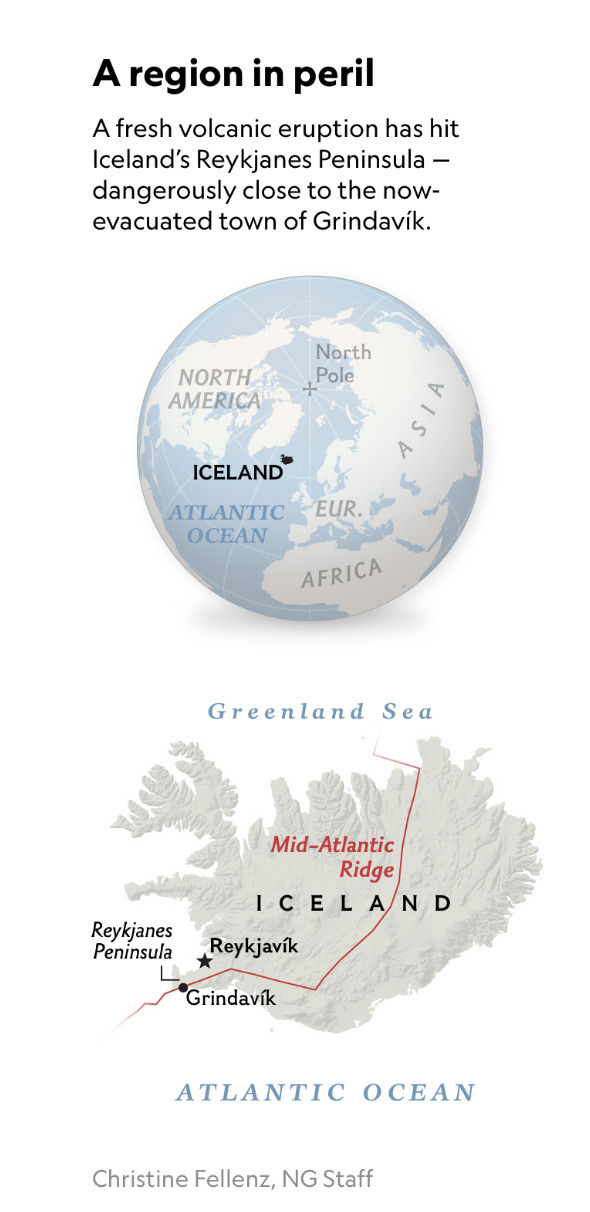
And it made quite an entrance: On November 10, the magma suddenly rose to within a few hundred feet of the surface, before pausing—all to the tune of a cacophony of rock-breaking quakes.
“This shift in the system reopening was honestly quite surprising. But it was the scale of the earthquake activity that took most people by surprise,” says Samuel Mitchell, a volcanologist at the University of Bristol. A pause between magma’s ascent and the onset of the eruption is not uncommon for fissure events, but this eruption’s prelude was especially intense and hasty.
By mid-November, it seemed very likely that an eruption along a 10-mile surface ‘corridor’ was going to happen in the coming days or weeks—a corridor that included Grindavík.

Iceland's Reykjanes Peninsula exploded in volcanic eruptions on December 18—creating an astonishing 2.5-mile-long fissure whose southern segment is seen here near the coastal town of Grindavik. Photograph By Marco Di Marco, AP Photo
Location, Location, Location
For the international eruption watchers, thoughts of another colossal, persistent, flight-grounding ash cloud—as was seen during Iceland’s 2010 Eyjafjallajökull eruption—attracted concern. Fortunately, as magma isn’t being directly injected into the underbelly of an ice sheet this time around, prolific ash-generating explosivity is extremely unlikely.
But its location did indicate that, unlike the past three events, this eruption could cause some serious damage
It was a good thing the molten rock’s prelude wasn’t subtle: It handily convinced authorities to swiftly evacuate Grindavík that same day in November, keeping residents far from any potential harm, while giving officials time to erect lava-deflecting walls around the power plant.
Still the eruption had an element of surprise: Lava began to spew just about two hours after an earthquake swarm just north of the town signaled the impending eruption—an astonishingly short interlude. That “underlines how close we were to an eruption soon after the initial evacuations last month, and the reason they were essential to ensure people's safety,” says Winder.
That the magma ultimately found a skylight near a series of ancient craters a couple of miles to the town’s northeast was briefly relieving. But the intensity of the eruption and the shocking growth of the fissure quickly made clear that the town to the south, and the power plant to the west, were in jeopardy.
For now, however, the grimmest of eventualities may have been avoided—all thanks to a mixture of luck and Icelandic proactivity.

Police have closed off the junction toward the town of Grindavík, which was evacuated in November as the threat of volcanic activity loomed. Experts say the hasty and intense eruption underlines how essential those evacuations were to ensure residents' safety. Photograph By Karim Iliya
The Fuzzy Future
That very little about the eruption is known with certainty also bolsters its intrigue.
Just a day into its paroxysm, the eruption noticeably calmed down, and it seemed possible that it would die out in a matter of days. Alternatively, experts say, this behavior might indicate that it will continue pumping out lava at that modest rate for months.
“If the magma stored at Svartsengi is still being renewed from depth, then the eruption could reach equilibrium at a lower intensity, and continue for quite some time,” says Winder. “It looks like there has been near-continuous magma supply there since late October, so it certainly seems realistic that it might continue for another two months into the future.”
That the region’s subsurface volcanic plumbing is a largely unresolved puzzle only exacerbates the uncertainty of this crisis. It simply isn’t clear why Svartsengi was the magma’s target this time round. Did it migrate from Fagradalsfjall, or did it come from another subsurface store? And why has the ground around Svartsengi inflated before without producing an eruption, whereas this time it succeeded?
In less than 24 hours after it began, researchers managed to sample some of the new eruption’s lava and compare it to the past three on the peninsula. And according to Ed Marshall, a geoscientist at the University of Iceland, they all have broadly similar chemistry. That implies there is some sort of magmatic connection between Svartsengi and Fagradalsfjall—but the nature of that connection is very fuzzy at present.
What volcanologists want to know, above all else, is what happened between the seismic dramatics of early November and this week’s eruption. Could they have been able to forecast exactly when and where the magma would find its way to the surface with the data they obtained in the weeks leading up to the outburst? “This is a great and intriguing question, which is at the core of what many people will be looking at in the coming months,” says Mike Burton, a volcanologist at the University of Manchester.
For now, all scientists can do is monitor the infernal proceedings—and hope that their observations will, eventually, reveal the secrets behind this novel show of volcanic force.

A volcanic fissure spews lava and smoke as it erupts near the town of Grindavík, Iceland, on January 14, 2024. The eruption is the latest in a series of outbursts that could continue in the region. Photograph By Snorri Thor, Nurphoto/Getty Images
#Iceland 🇮🇸#Reykjanes Peninsula#Most Dangerous Eruption 🌋#Grindavik Town#Tom Winder | Volcano Seismologist | University of Iceland 🇮🇸
1 note
·
View note